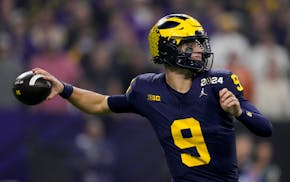The guy who makes the Detroit Tigers go is not signed to a $153 million contract (Miguel Cabrera), isn't closing in on 500 home runs (Gary Sheffield), isn't playing his third position in six months (Carlos Guillen), isn't a formerly Pudgy future Hall of Famer who's shrinking faster than the American dollar (Ivan Rodriguez).
The guy who makes the Tigers go is one of the first players you'd send to a foreign country to promote baseball (he went to Africa last winter to do so), one of the first players you'd want in your clubhouse (he's got two college degrees and signs enough autographs for the whole team) and the first player Detroit sends to the plate every night.
Curtis Granderson, the Tigers leadoff hitter and center fielder, is coming off one of the most remarkable seasons in baseball history, so it shouldn't be surprising that the end of the Tigers' early-season swoon dovetailed with his return from the disabled list.
Detroit is 6-4 since Granderson's return from a broken hand, having gone 8-13 without him. After going 2-for-4 with a homer that accounted for the Tigers' lone run in Saturday night's 4-1 loss to the Twins, he is hitting .297 with four homers, three doubles, a triple and seven RBI in 10 games, having drawn eight walks and compiled a slugging percentage of .757.
Ten games is a small sample size; the 2007 season was not. Granderson hit .302 with 23 homers, 74 RBI and a league-leading 23 triples, becoming the second player in big-league history to have at least 30 doubles, 20 triples, 20 homers and 20 steals in a season, a feat that was matched later in the year by Philadelphia's Jimmy Rollins.
That season led Tigers General Manager Dave Dombrowski to make Granderson the first player in Detroit he has signed to a long-term contract extension before he was eligible for arbitration. Granderson signed a five-year, $30.25 million contract in February, perhaps signalling the time to move out of his parents' house. "I'm looking," he said.
His parents were teachers. Granderson attended Illinois-Chicago and decided he wanted to be a Division I basketball player. "It took me all the way to my sophomore year of college to realize I was a better baseball player than basketball player," Granderson said.
The epiphany? "A broken thumb in fall practice my sophomore year, in baseball," Granderson said. "That was when I was ready to start basketball practice. We were running a pickoff play to second base. I was the baserunner. I dove in, the shortstop fell on me, and when I went to get up he went to push up off of me and fell on my thumb.
"So I couldn't start basketball practice, but I could still do baseball practice, which I was on scholarship for. I could bunt, go out in the outfield and shag, and do conditioning. Luckily for me it was in the fall, it healed up over the winter and I was able to play in the spring."
Granderson said that injury changed the course of his career. "I don't think I would have ended up in the same place without that," he said. "The first thing is, if I had the option to play basketball, I was going to play. I wasn't necessarily going to be great, but my whole thing was, I wanted to play Division I basketball and I would have been happy.
"The basketball team went to the NCAA tournament, and if you look at when the season would have ended, I wouldn't have gotten that much development or that many at-bats. I still would have been able to play, but I don't think I would have been able to excel to the point where I would get drafted my junior year."
Granderson wound up finishing his degrees and becoming a blogger and a baseball ambassador, all of which means a lot more if you can play. Today, the one-time aspiring college basketball player might be one of the most important figures on a team loaded with talent and expectations.
"I'll take full responsibility if for some reason we seem flat," Granderson, who ended an 0-for-11 stretch with a sixth-inning infield single Saturday. "If I'm leading off and all of a sudden I have four bad at-bats and we end up losing the game with a few amount of hits, then that's my fault."
The first player Granderson wrote to as a kid was Kirby Puckett. When Granderson reached the big leagues, he realized how many requests a popular athlete receives, and he resolved to treat fans the way Puckett treated him.
Unfortunately for American League pitchers, Granderson is also treating them the way Puck did -- badly.
Jim Souhan can be heard Sundays from 10 a.m.-noon on AM-1500 KSTP. • jsouhan@startribune.com

Souhan: Wolves fans made Game 1 special. Now bring on Game 2.

Souhan: Should Vikings even consider McCarthy in NFL draft?

Souhan: NAW erases Suns' lead, Game 1 advantage with big performance

Souhan: This is KAT's chance to prove Flip Saunders was right


